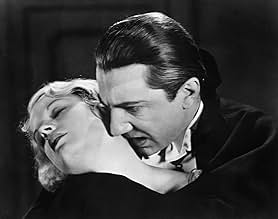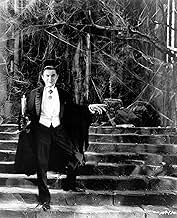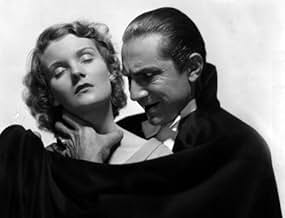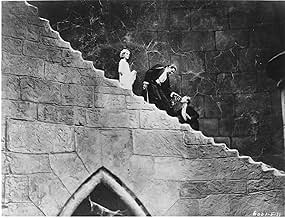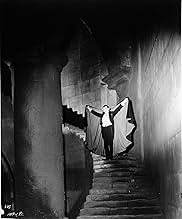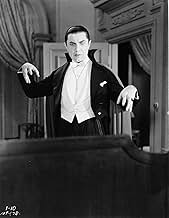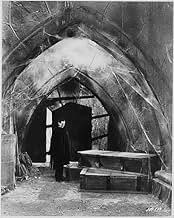Dracula
- 1931
- Tous publics
- 1h 15m
IMDb RATING
7.3/10
63K
YOUR RATING
Transylvanian vampire Count Dracula bends a naive real estate agent to his will, then takes up residence at a London estate where he sleeps in his coffin by day and searches for potential vi... Read allTransylvanian vampire Count Dracula bends a naive real estate agent to his will, then takes up residence at a London estate where he sleeps in his coffin by day and searches for potential victims by night.Transylvanian vampire Count Dracula bends a naive real estate agent to his will, then takes up residence at a London estate where he sleeps in his coffin by day and searches for potential victims by night.
- Awards
- 5 wins & 3 nominations total
Charles K. Gerrard
- Martin
- (as Charles Gerrard)
Anna Bakacs
- Innkeeper's Daughter
- (uncredited)
Bunny Beatty
- Flower Girl
- (uncredited)
Nicholas Bela
- Coach Passenger
- (uncredited)
Daisy Belmore
- Coach Passenger
- (uncredited)
William A. Boardway
- Concertgoer Outside Theatre
- (uncredited)
Barbara Bozoky
- Innkeeper's Wife
- (uncredited)
Tod Browning
- Harbormaster
- (voice)
- (uncredited)
Moon Carroll
- Maid
- (uncredited)
Geraldine Dvorak
- Dracula's Wife
- (uncredited)
Featured reviews
... and that explains all of the differences, such as Renfield being the person to visit Dracula in Transylvania to seal a real estate deal rather than Jonathan Harker.
I imagine this was quite the spectacle in 1931. Visually it still is - sweeping staircases, ruined old castles covered in dust, moonlight illuminating giant spiderwebs, coffins with limbs hanging out of them, rats scurrying about. And Bela Lugosi, who starred in the Broadway play, was dying to play the lead. But director Tod Browning was set on Lon Chaney, a frequent collaborator, playing both Dracula and Van Helsiing.
It's not true that everybody is replaceable, but it IS true that eventually an irreplaceable person will no longer be around and a perhaps less than ideal work-around must be found. This was the situation with Chaney - a unique actor who could convince you he was anybody. He died before Dracula was filmed. Lugosi successfully lobbied for the part, although he did so at a cut rate. Today his old world hypnotic presence is synonymous with the role.
But I have to admit I have an unpopular opinion. To me Dracula seems very slow and very much "early talkie" in personality when compared to the film Frankenstein of just a year later. Also, like many early talking films that were not musicals, there is no score.
And I have to wonder about director Tod Browning. Although this was Browning's biggest hit, his other enduring works all starred Lon Chaney. He only directed a few more films and disappeared from the industry for a quarter of a century until his death. He had a disappearing act worthy of Universal Horror.
Things to watch for - Armadillos in Transylvania? Probably far too cold for them there. David Manners and Helen Chandler as young lovers Jonathan Harker and Mina - They have all of the chemistry of two cardboard boxes. Why did they keep pairing these two in films? Dwight Frye as Renfield - did Frye EVER get to play a normal person? And why would he want to be sent away? He gets to wander in and out of the lush living quarters of the superintendent f the mental facility. He wouldn't get that freedom anywhere else. And last but not least, Carla Laemmle, unrecognizable as a tourist, reading from a Transylvania tour guide.
I imagine this was quite the spectacle in 1931. Visually it still is - sweeping staircases, ruined old castles covered in dust, moonlight illuminating giant spiderwebs, coffins with limbs hanging out of them, rats scurrying about. And Bela Lugosi, who starred in the Broadway play, was dying to play the lead. But director Tod Browning was set on Lon Chaney, a frequent collaborator, playing both Dracula and Van Helsiing.
It's not true that everybody is replaceable, but it IS true that eventually an irreplaceable person will no longer be around and a perhaps less than ideal work-around must be found. This was the situation with Chaney - a unique actor who could convince you he was anybody. He died before Dracula was filmed. Lugosi successfully lobbied for the part, although he did so at a cut rate. Today his old world hypnotic presence is synonymous with the role.
But I have to admit I have an unpopular opinion. To me Dracula seems very slow and very much "early talkie" in personality when compared to the film Frankenstein of just a year later. Also, like many early talking films that were not musicals, there is no score.
And I have to wonder about director Tod Browning. Although this was Browning's biggest hit, his other enduring works all starred Lon Chaney. He only directed a few more films and disappeared from the industry for a quarter of a century until his death. He had a disappearing act worthy of Universal Horror.
Things to watch for - Armadillos in Transylvania? Probably far too cold for them there. David Manners and Helen Chandler as young lovers Jonathan Harker and Mina - They have all of the chemistry of two cardboard boxes. Why did they keep pairing these two in films? Dwight Frye as Renfield - did Frye EVER get to play a normal person? And why would he want to be sent away? He gets to wander in and out of the lush living quarters of the superintendent f the mental facility. He wouldn't get that freedom anywhere else. And last but not least, Carla Laemmle, unrecognizable as a tourist, reading from a Transylvania tour guide.
It's almost impossible not to love 'Dracula', a horror milestone that is the most important and influential vampire movie ever made. Bela Lugosi became a cinematic legend after this movie, and his portrayal of Dracula basically invented the modern vampire as we know it. Murnau's silent classic 'Nosferatu' was an obvious influence on Todd Browning, but while Browning was no James Whale (the innovative British director who made 'Frankenstein' for Universal a few months after this) he added a lot of his own style and ideas to the project, and Counts Orloff and Dracula are completely different kinds of creatures. Lugosi made his Count sophisticated, attractive and sexy, and this is what made this movie such a sensation at the time, and what helps make it still a wonderful viewing experience. Lugosi's performance is one of the greatest in horror history. Some of the other actors in the cast are a bit shaky but Edward Van Sloan as Van Hesling is excellent and Dwight Frye's Renfield (a different character from the book) is also memorable. Both actors would reappear in 'Frankenstein'. 'Dracula' is an important landmark horror movie, but even better, is still a fantastic viewing experience seventy years later. Don't just watch it because it's a classic, watch it because it's wonderful entertainment!
(62%) It is without doubt a classic owing to the fact that it is so well made, and so memorable. The sets are some of the greatest ever to appear on any film, and Lugosi is great as the awful head vamp. It's more than a little dated of course, so there's no blood/biting or on-screen death or murder, plus the acting is very theatrical at times, and there's quite a few long drawn-out sections of total silence that highlight exactly how old and pioneering it is.With that said, all horror fans should watch this at least once, as it does make a great late-night Halloween movie that will live on - just like the old count himself - forever.
This is the movie that set the horror genre into action. Sure there may be a few campy scenes that look like they might be out of some high school play production (the rubber bats and armadillos in Dracula's castle come to mind), but there is an unmistakable suspense and eerieness about the film. If you are lucky enough to find the DVD reissue from 1999, you have three great versions: the original 1931 version with basically no background music, the 1999 rescoring of the movie by composer Philip Glass, and the extremely interesting Spanish version, made at the same time as the original (with totally different actors). If you have this DVD, watch the movie twice: once with no soundtrack and once with the Glass rescoring.... totally different movie. Glass' score is great, but it doesn't really help the movie at all (it actually hurts it in many cases). But the utter silence in Browning's original just makes my skin crawl! The acting is actually quite great (Lugosi is, of course, phenomenal as is Dwight Frye as Renfield). The fear, the suspense, and, believe it or not, the sexuality, combines for a great movie that was an unbelievable success in its first release ($700,000 in it first US release, $1.2 million worldwide). Not bad for a movie made 72 years ago!
The 1931 `Dracula' casts an imposing shadow over the horror genre. It is, after all, the movie that launched the classic Universal horror cycle of the 1930s and 1940s. It is also a tremendous influence on the look and atmosphere of horror movies in general (and vampire movies in particular). It gave Dracula a look and a voice, and created a legend.
Okay, so we know it was influential. But how does it work as a movie? Well the first time I watched it, I was underwhelmed. The pace is slow. While Bela Lugosi's Dracula is menacing, the rest of the cast is colorless to the point of transparency. There are some good gliding camera shots here and there (thank you, Karl Freund!), but the majority of the film is locked into stationary medium and long shots. The film is tightly bound to its theatrical origins director Browning has his characters look at things out of frame and describe them rather than just showing us, which would be much more effective.
Fortunately, `Dracula' improves with repeated viewings. The glacial pace and lack of sound in many places gives the movie a nightmarish sense of menace. In fact, `Dracula' is somewhere between a nightmare and a piece of classical music everything proceeds at its own pace, gliding through the motions, gradually building suspense and momentum until the piece reaches climax. The end result is a flawed but haunting, hypnotic masterpiece, and one of the greatest vampire films ever made.
Okay, so we know it was influential. But how does it work as a movie? Well the first time I watched it, I was underwhelmed. The pace is slow. While Bela Lugosi's Dracula is menacing, the rest of the cast is colorless to the point of transparency. There are some good gliding camera shots here and there (thank you, Karl Freund!), but the majority of the film is locked into stationary medium and long shots. The film is tightly bound to its theatrical origins director Browning has his characters look at things out of frame and describe them rather than just showing us, which would be much more effective.
Fortunately, `Dracula' improves with repeated viewings. The glacial pace and lack of sound in many places gives the movie a nightmarish sense of menace. In fact, `Dracula' is somewhere between a nightmare and a piece of classical music everything proceeds at its own pace, gliding through the motions, gradually building suspense and momentum until the piece reaches climax. The end result is a flawed but haunting, hypnotic masterpiece, and one of the greatest vampire films ever made.
Did you know
- TriviaGenerally regarded as the film that kickstarted the horror genre in Hollywood.
- GoofsIn the scene where Van Helsing is attempting to catch Dracula's lack of reflection in a mirror, there are visible chalk marks on the floor showing Bela Lugosi where to stand for the shot.
- Quotes
Count Dracula: This is very old wine. I hope you will like it.
Renfield: Aren't you drinking?
Count Dracula: I never drink... wine.
- Crazy creditsThe original title card has producer Carl Laemmle, Jr. identified as Presient (sic).
- Alternate versionsA version of the film played on the 10/24/15 airing of Svengoolie (1995) featured a soundtrack taken from the French language audio track on the Dracula Blu-ray.
- ConnectionsAlternate-language version of Drácula (1931)
- SoundtracksSwan Lake, Op.20
(1877) (uncredited)
Music by Pyotr Ilyich Tchaikovsky
Excerpt Played during the opening credits
Details
- Release date
- Country of origin
- Official site
- Languages
- Also known as
- Drácula
- Filming locations
- Production company
- See more company credits at IMDbPro
Box office
- Budget
- $355,000 (estimated)
- Gross worldwide
- $87,019
- Runtime
- 1h 15m(75 min)
- Aspect ratio
- 1.20 : 1(original release)
Contribute to this page
Suggest an edit or add missing content


